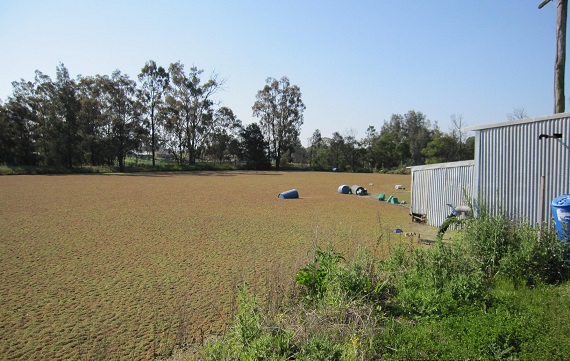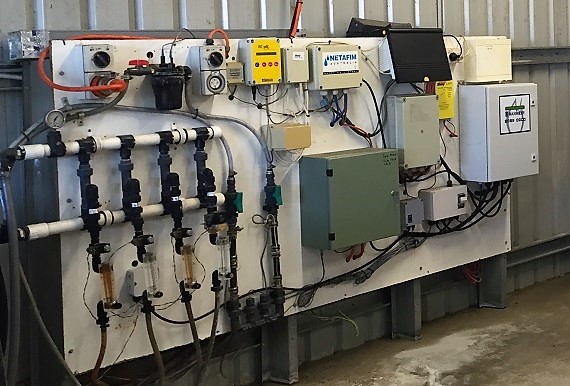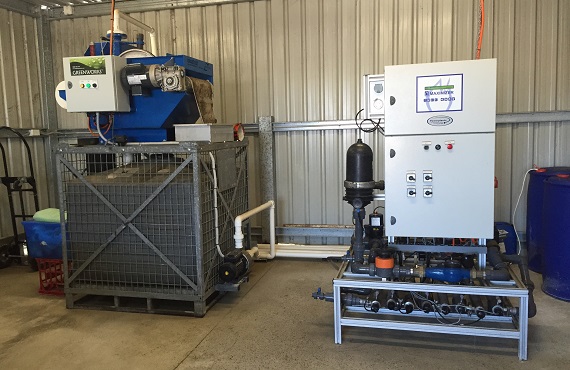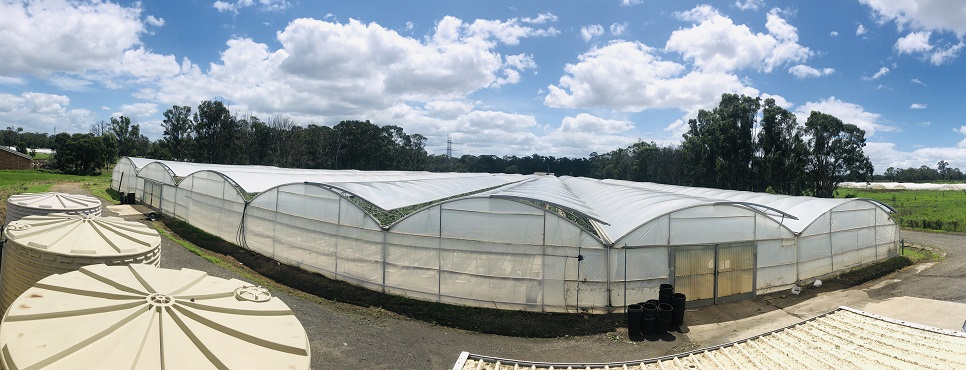
Greenhouse drain water recycling in protected cropping – the rewards and the realities
Luke Jewell, NSW Department of Primary Industries Research and Development Officer
Converting to a closed irrigation recycling hydroponic system can dramatically cut water use and reduce expensive fertiliser inputs, but careful planning is needed to avoid risks to production.
This article looks at the benefits and technical challenges that face the protected cropping sector, particularly small to medium enterprises, when retrofitting an irrigation capture and recycling system in an existing operation.
In the protected cropping sector, investment in high technology fertigation and recycling systems can deliver significant advantages to the grower including:
- attractive productivity and return on investment where systems can be managed to their full potential
- savings of up to 50% on fertiliser inputs
- reduced business risk through minimising water use and demonstrating environmental stewardship by preventing nitrogen and phosphorus from entering sensitive waterways
Many growers struggle with the cost and complexity of retrofitting a recycling system to their current setup. The good news is that a shift to recycling can be a viable investment for a small to medium enterprise. Just as importantly, there are other measures growers can take that may better suit their current farm context, helping them shift towards a more efficient production system which will also be beneficial to their bottom line.
For corporate farms with the resources to ensure a high technology system is well managed, investment in irrigation recycling can be an easy decision. However for small to medium enterprises with an existing low to medium technology system, the transition to irrigation recycling needs to be based on a very different set of considerations.
Farm topography
In order to efficiently and cost effectively capture your drain water (the irrigation water that drains from your grow bags or pots) the greenhouse floor must be relatively level.
For growers who are shifting from an open field soil-based system to a covered hydroponic artificial media-based system, an undulating site can be the major barrier to retrofitting a recycling system. Capture of the drainage water in the guttering system on an undulating site will be difficult, creating the potential to induce algal growth around your nutrient rich fertigation solution. Therefore, the cost of conversion may not be justifiable in this type of situation.
In contrast, growers with existing greenhouse systems on level ground can more easily progress to retrofitting a water recycling system.
Water source - why is water quality so important?
Many small to medium protected cropping businesses develop in clusters around city fringes. This tends to lead to smaller lot sizes with limited ability to capture water on farm (via dams). The quality and quantity of off farm water sources can vary greatly. Those with access to high quality potable (town) water pay town or municipal water prices (over $2,000 per ML in most cases) and can make large dollar savings by moving to water recycling.

In order to return drain water from your high value crop back into the same greenhouse, the water must be treated to lower the risk of water borne disease entering the system. This is known as disinfestation or disinfection.
There are several technologies available which have been in use in intensive horticulture and elsewhere for many years and are well researched. These will all work well if you are treating pathogens in clear, filtered water.
Water turbidity reduces the effectiveness of disinfection technology. Research has shown that when water is sourced from a typcial farm dam, the effectiveness of these technologies is significantly reduced when the water is more turbid. (*i)
Crop type
The crop being produced will influence the type and the likely success of a recycling system. All horticultural crops are susceptible to disease, however fleshy herbaceous crops like tomatoes and cucumbers are more susceptible than woody perennial crops such as berries. Regardless of the crop type, the risk of infection is greater when water is recycled back into the host crop, increasing the need for high quality disinfection. As a general rule, all high value vegetable and fruit crops require high capacity disinfection to maximise the potential for safe recycling of irrigation drain water.
Where high capacity disinfection is deemed uneconomic, reuse of the drain water on a different crop or to water a grassed paddock nearby, can be a workable alternative to dispose of irrigation drain solution. The crop you intend to reuse the water on should be from a different botanical family with no known susceptibility to the pathogens affecting the host crop.
Reuse onto grassed areas also needs to account for nutrients which will be applied in a given area over time in order to comply with local or state regulations.
Greenhouse type and level of climate control
As described by Protected Cropping Australia, "Protected cropping is about control, and technology is largely focussed on increasing that control."
"At the high-tech end of the industry, this amounts to almost total control over the plants growing environment, from the root zone through to the atmosphere."
"The level of control, particularly of the atmosphere, decreases for medium and low-tech protected cropping structures."
"Low technology consists of polytunnels, which are open at each end, without any automation or control.;
"Medium technology consists of enclosed polyhouses for which the sides can be opened and closed, allowing some degree of control of the inside temperature and humidity.” (*ii)
If your enterprise currently has limited control over the growing environment, as can be the case with low technology systems, crops may be more susceptible to disease. Crops in low technology systems may also be more susceptible to attack from insects which are vectors for a range of viruses. Recycling drain water back into this type of sub-optimal environment may not be advisable.
Fertigation system
A direct injection fertigation system with pH and EC control is highly recommended for all types of water recycling system as you will need to accurately monitor and control the EC and pH of the solution as the return water is blended with your source of raw water.

Substrate (growing media)
Inert (non-reactive) growing medias like rockwool or perlite are preferred, as they are unlikely to reduce or interfere with the effectiveness of the disinfestation treatment. Coco peat (coconut fibre) is a commonly used substrate in Australia which is not inert. Growers converting to a recycled system need to be aware that the drain water captured from coco peat-based grow bags will contain tannins and other compounds for at least 4-8 weeks after initial irrigations. These compounds will cloud the water and make it difficult to disinfest and recycle the drain water safely. However, drain water recycling can safely commence after this initial period.
Farm hygiene
Practicing whole farm hygiene is critical to the success of any protected cropping enterprise. If you wish to successfully recycle your irrigation drain water back into your high value crop, this is non-negotiable.
The NSW DPI publication ‘Keep it Clean’ provides a comprehensive guide to greenhouse production including the following essential management practices:
* Be able to correctly identify pests and diseases (or have them identified for you) and routinely conduct a pest and disease check to ensure early detection and correct identification of problems
* Action points are determined and pest and disease check information is used for all decision making including chemical, biological, and whole-crop and hot-spot treatments
* The greenhouse is within a ‘clean’ zone which is quarantined from the ‘outside’ zone of the farm
* Check and control points are used to control movement of people, vehicles, plants and materials into the ‘clean’ zone
* Employees and visitors do not visit another greenhouse before entering your greenhouse
* All seedlings are checked and found free from pests and diseases before they are planted out
* A 5 - 10 metre wide clean buffer area is maintained around every greenhouse
* The greenhouse is always cleaned and disinfected before planting new crop
* The greenhouse and farm surrounds are kept weed free
* Crop debris is removed and stored/disposed of outside the ‘clean’ zone and away from the greenhouse
Grower technical skills and available support
The technology needed to successfully support a recycling system necessarily requires technical skills and knowledge from the grower. In some cases, highly motivated growers will seek out training and information and find their own way to success. Others have had success in hiring qualified consultants who can guide them through the process.
Government and industry provide a wide variety of advisory materials and training opportunities. It is important to identify and develop the minimum level of knowledge required to successfully utilise recycling technology, before making the transition. When making the investment, it is advised that a support package with the technology suppliers is established to provide in field training and troubleshooting.
Doing the possible
After you have considered your farm context, your skill level, and the support available, it is time to consider whether pressing ahead with a full recycling system is your current best option. If converting to an irrigation recycling system is not feasible at this stage, there are steps you can take in the meantime that will start you on your way to a more efficient and productive system:
- Get to know your source water quality
- Set up a sampling station and measure drip vs drain EC and pH, then measure the volume of your drain percentage
- Automate irrigation timing and delivery and work on saving water and fertiliser through accurately scheduling irrigations
- Make hygiene a priority
- Get objective advice before investing in technologies with significant capital and/or ongoing product maintenance and operating costs.
Australian greenhouse growers, the protected cropping industry as a whole, and the wider community stand to benefit from growers adopting drain water recycling. For this to occur, industry may need to invest in research to identify the key barriers to adoption, as well as improved training and education programs in partnership with commercial suppliers and government.
This article has been prepared as part of the NSW Department of Primary Industries Clean Coastal Catchments (CCC) project which is working with agricultural industries in coastal areas to improve on farm fertiliser and water management. Improved management of fertiliser and water on farm will assist farmers and the food industry to be more productive, profitable and environmentally sustainable, while reducing negative impacts on coastal creeks, rivers and sensitive marine areas.
The CCC project is funded by the NSW Government through the Water Quality Initiative of the Marine Estate Management Strategy.
You can hear further discussion on safely capturing and recycling nutrient rich runoff in the CCC 'Recycling Ins and Outs’ Webinar recording.
For more information email the CCC project team at: ccc.info@dpi.nsw.gov.au
This article was originally published in the Autumn 2022 edition of Soilless Australia magazine: https://protectedcropping.net.au/publications/soilless-australia/
* REFERENCES
Thompson, R.; Delcour, I.; Berckmoes, E.; Stavridou E; (2018) The Fertigation Bible - Technologies to optimise fertigation in intensive horticulture. https://www.fertinnowa.com/the-fertigation-bible
[i] Scarlett, K.; Collins, D.; Tesoriero, L.;Jewell,L: van Ogtrop, F.; Daniel, R. (2015) Efficacy of chlorine, chlorine dioxide and ultraviolet radiation as disinfectants against plant pathogens in irrigation water. Eur J Plant Pathol DOI 10.1007/s10658-015-0811-8 https://www.nwsolutions.com.au/wp-content/uploads/2017/06/CleanOxide-75-DPI_2015_Efficacy-of-disinfectants.pdf
[ii] What is protected cropping? Protected Cropping Australia website: https://protectedcropping.net.au/the-protected-cropping-industry/



